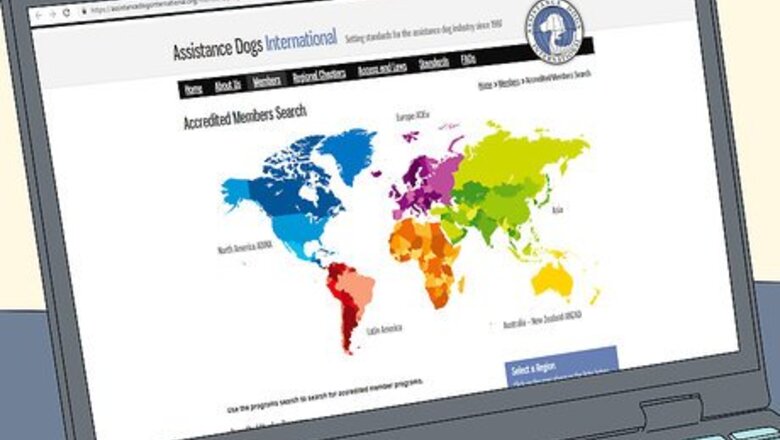
views
Applying for a Service Dog
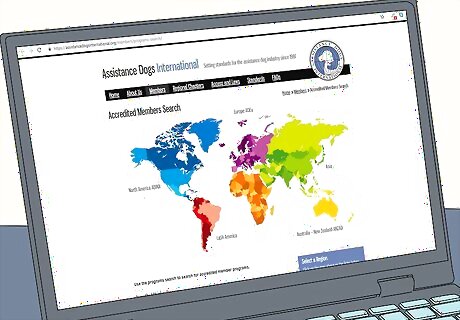
Look for a program accredited by Assistance Dogs International (ADI). To avoid scams and unqualified trainers, be sure to apply to an accredited service dog program. Enter your location into ADI’s online search tool to find credible national and local programs that serve your area. Begin your search at https://assistancedogsinternational.org/members/programs-search. The search tool will generate a list of accredited programs with links to their websites. Click on the links to research each program's cost, application process, and eligibility requirements.
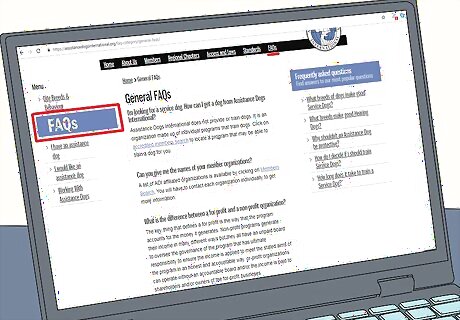
Review the costs charged by potential programs. Check programs’ FAQ or About pages for information about eligibility and costs. In the U.S., several national organizations, such as America’s Vet-Dogs and K9s for Warriors, offer PTSD service dogs for military veterans and first responders free of charge. Other programs, such as Service Dogs for America, serve both veterans and civilians. Generally, service dogs for civilians aren’t free; total costs can exceed $20,000 (U.S.). That said, service dog organizations that don't cover costs outright typically help with fundraising efforts.
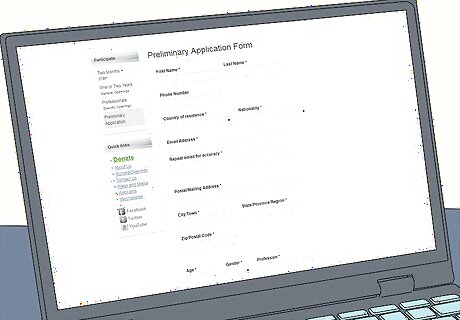
Fill out a preliminary application online. Application processes vary slightly, but submitting a preliminary application is typically the first step. You’ll need to provide your personal information, enter your service and discharge details (if you’re a veteran), answer questions about your needs, and verify that you understand the responsibilities of caring for a service dog. Some organizations require a mental health evaluation and military discharge forms (if applicable) with the preliminary application. For others, this additional paperwork comes later in the process. Review your program’s website for specific steps to the application process. It may take 4 to 6 weeks for the preliminary application to be processed. If you’re approved, you’ll receive a letter with information about the next steps. Note that preliminary approval doesn’t guarantee your full application will be accepted.
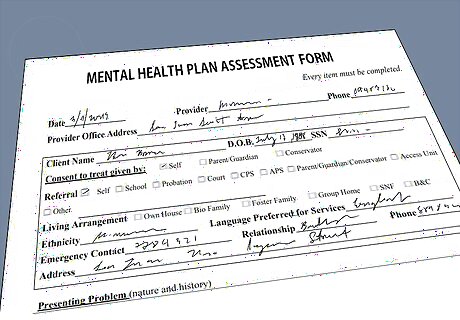
Submit a mental health evaluation completed by your therapist. A licensed mental health professional must verify your diagnosis and affirm that you attend therapy sessions at least once a month. Their evaluation will also include information about the specific tasks you need a service dog to do. The application will include an evaluation form or prompt, which your therapist will fill out and mail to the program. Before and throughout the application process, discuss your needs with your therapist. Ask them how a service dog should contribute to your treatment plan. Keep in mind a service dog is just one part of treatment and doesn't replace ongoing mental health care.Examples of tasks: Specific needs vary, but common PTSD service dog tasks include waking a person up from night terrors, providing physical contact during a panic episode, and diverting a person’s attention away from triggers.

Complete interviews in-person and, if necessary, via telephone. Within 3 to 4 weeks of submitting your application and supporting documents, the organization may schedule a phone interview with you. Not every program requires a phone interview, but almost all conduct home visits. Try not to overthink the interviews; be yourself, be honest about your needs, and demonstrate that you’re able to give a service dog the love and care it needs. Phone and in-person interviews also help the program’s staff match you with a service dog that suits your needs, family, and environment. Your therapist may also need to sit for a phone or in-person interview.

Wait at least 6 to 8 weeks for your application to be processed. Expect to receive a decision by mail within 8 weeks of submitting your full application and additional paperwork. If you’re approved, you’ll most likely be put on a wait list, which may last 6 months to 2 years. Counting the preliminary application, the complete application process usually takes about 2 to 3 months total. Typically, you can’t reapply to a program if your application isn’t approved. However, you could apply to another service dog organization. If you’re not approved, contact the program, ask why you’re not eligible to receive a service dog, and factor their feedback into your next application.
Affording a Service Dog
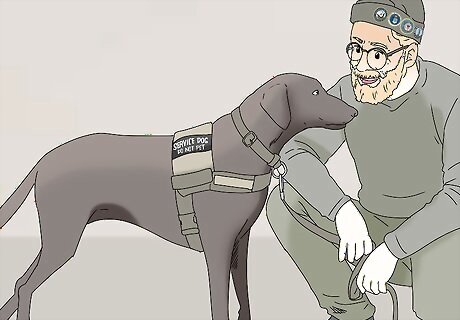
Look for a program that provides free service dogs. In the U.S., there are plenty of programs that offer service dogs for veterans and first responders free of charge. When you research programs, look for service dog organizations that raise funds to cover their clients' expenses.Tip: Additionally, veterans can apply for a benefit that covers the cost of veterinary care. Your VA mental health provider applies on your behalf through the Department of Veterans Affairs Mental Health Services Office.

Consult your program’s financial aid counselors after you're approved. If your program doesn’t cover the cost of a service dog, they’ll most likely provide financial aid counseling. Begin your fundraising efforts as soon as your application has been approved. Start by asking your program's financial aid counselors about local and national grant programs, and seek advice about planning successful fundraisers. Additionally, ask your financial aid counselors if you can set up a payment plan that’s in your budget.
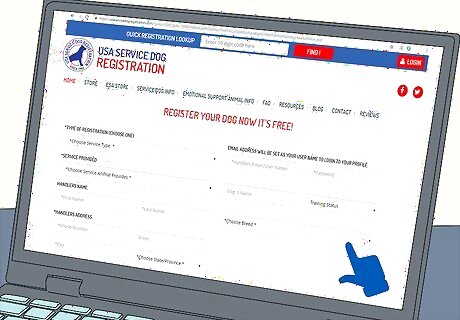
Apply for grants and scholarships. Search online for “service dog grants” plus your country and state. Your financial aid counselor can also put you in touch with non-profit organizations that award grants and scholarships for service dogs. Grant application processes vary, but you’ll most likely need to provide your personal and financial information, documentation of your diagnosis, and verification that you’ve been approved by an ADI-accredited program. You can also find financial aid resources, including links to grant programs, through the International Association of Assistance Dog Partners at http://www.iaadp.org.
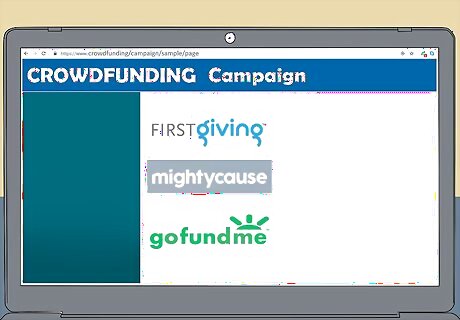
Launch an online crowdfunding campaign. Create a page on a crowdfunding platform such as First Giving, Mighty cause, or GoFundMe. You'll need to get help setting up a crowdfunding site from your financial aid counselor. The organization will stipulate that the funds go directly to them, and you'll have to enter their financial information when you set up your page. When you create your page, explain your needs clearly, concisely, and openly. Describe your needs and the specific costs you need to cover. Bear in mind you don’t need to share every detail of your disability if it makes you uncomfortable. Check your approval packet or ask your financial aid counselor for a breakdown of costs. Itemized costs include the dog itself, a 2 to 3 week mandatory training program, travel and lodging for the training program, and the dog’s service vest and ID. After setting up your page, share it on your social media accounts, and ask your friends, family, and colleagues to do the same. You should also contact local newspapers and TV news stations. They may be interested in running a story on your fundraising efforts.

Organize fundraising events with local businesses. Send an email, mail a standard letter or, if you’re comfortable in public places, visit businesses in person to see if they’d be willing to partner on an event. You could also ask your employer, school, or place of worship if they'd be interested in hosting a fundraising event. For example, ask a restaurant in your area if they could host a benefit on your behalf. They could donate a percentage of the benefit night’s sales or of the sales of a specific menu item to your cause. They could also collect additional donations from their guests on your behalf. National chain restaurants frequently host fundraisers to help people pay for service dogs. Privately owned businesses are also worth a shot, especially if you know the owner cares about causes related to mental health and service animals.
Completing the Training Program

Meet potential service dogs at 2 or more assessments. The organization will most likely introduce you to more than one dog that they’ve matched with you based on your application forms and interviews. You'll meet potential service dogs at 2 or more assessments, then organization's staff will pair you with your new companion. The organization's staff will match you with a service dog that best meets your needs, but you'll have final approval. Once you've been matched, you and your new dog will learn how to work together at an intensive training course. Matching procedures vary, so check with your program for specific information.

Attend a 2 to 3 week course on living with a service dog. After you’ve been approved and have secured funding (if applicable), you’ll need to complete an in-person training program. Usually, these classes are held at the service organization, and you’ll stay on-site in an apartment or dormitory. Some programs cover the cost of the training program, lodging, and transportation. If yours doesn’t, you can include these expenses in your fundraising goal. At the training program, you’ll learn how to give your dog commands, how to care for it, and about your rights as the owner of a service dog.
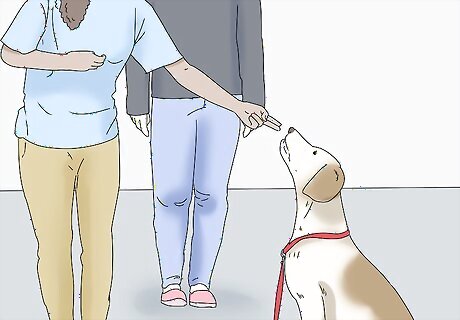
Practice giving your dog commands with the guidance of trainers. Before you arrived, your dog spent 6 months to 2 years learning how to perform the specific tasks you need. When you get to the training program, staff will show you firsthand how to interact with your service dog. For example, “Cover” is a common PTSD service dog command that you may practice. You’d give the command if you experience a panic episode. Then, depending on its training, your dog would make physical contact with you, retrieve medication, or complete another task to relieve your symptoms.Tip: The main purpose of the class is to train with your dog, but building a bond is important, too. Play together and spend as much quality time as possible with your new best friend. Trainers will also likely suggest sleeping with your service dog to reinforce your bond.
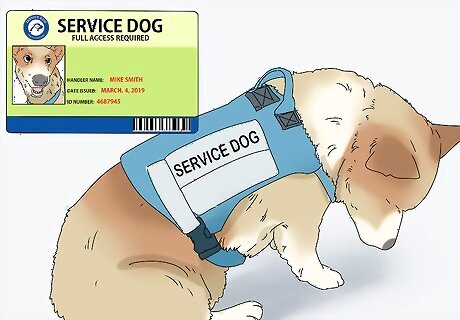
Obtain your service dog’s vest and ID card after finishing the class. At the end of the training program, you’ll receive your service dog’s gear and paperwork. If the organization didn’t cover the costs of a vest and ID outright, they were listed in your financial aid breakdown and can be included in your fundraising goal. In the U.S., you’re generally not required to carry registration paperwork or discuss the nature of your disability. However, airlines may require you to show your service dog’s documentation up to 48 hours before your flight. They may also ask for a letter from your therapist and your therapist's licensing information.

Complete any ongoing assessments required by your program. Follow-up procedures vary by program, but you’ll most likely have quarterly home visits during the first year. Thereafter, you may need to attend video or in-person training sessions every 1 to 2 years. Programs conduct follow-up assessments and training just to make sure your service dog is meeting your needs and you’re providing proper care. Even if your program doesn’t require ongoing home visits, you’ll still need to check in via telephone or video. Additionally, most programs require clients to provide verification every 1 to 2 years that they’re continuing to attend monthly therapy sessions.


















Comments
0 comment